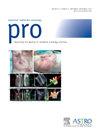Stereotactic Body Radiation Therapy Versus Conventional Radiation Therapy for Painful Spinal Metastases: A Comparative Analysis of Randomized Trials and Practical Considerations
IF 3.4
3区 医学
Q2 ONCOLOGY
引用次数: 0
Abstract
Purpose
Recent randomized trials have compared the efficacy and safety of stereotactic body radiation therapy (SBRT) with those of standard conventional external beam radiation therapy (cEBRT) for the treatment of painful spinal metastases. We conducted a composite analysis of these trials in order to inform current practice using pooled outcomes.
Methods and Materials
Data from each randomized trial were abstracted from the final publications with biologically effective doses (BEDs) recalculated for SBRT and cEBRT. Primary outcome measures were overall pain response (OR) and complete pain response (CR) rates at 1, 3, and 6 months and rates of vertebral compression fracture. Random effects models were used to estimate primary outcome measures, and meta-regression assessed the effect of BED.
Results
Four prospective randomized clinical trials published between 2018 and 2024 were included, with a total of 686 patients (383 and 303 in the SBRT and cEBRT groups, respectively). Dose and fraction (fx) number ranged from 24 Gy/1 fx to 48.5 Gy/10 fx for the SBRT group (median BED using an α-to-β ratio of 10, 50 Gy) and from 8 Gy/1 fx to 30 Gy/10 fx for the cEBRT group (median BED using an α-to-β ratio of 10, 28 Gy). The 1-, 3-, and 6-month OR rates for SBRT and cEBRT were similar: 53.6%, 52.4%, and 58.8% versus 48.4%, 47.9%, and 43.8%, respectively (p > .05). The 3-month CR rate was significantly higher for SBRT than for cEBRT (31.9% vs 14.8%; risk ratio, 2.26; 95% CI, 1.48-3.45; p < .001), but not the 6-month rate (34.4% vs 16.3%; risk ratio, 1.83; 95% CI, 0.74-4.53; p = .194). Vertebral compression fracture rates were similar at 17.3% and 18.4% for SBRT and cEBRT, respectively. No significant dose-dependent effect was observed with increasing BED for any efficacy or safety outcomes.
Conclusions
OR rates are similar, but CR rates appear higher with SBRT than with cEBRT, yet no dose-dependent effects were identified despite approximately 1.8 × BED dose with SBRT.
SBRT与传统放疗治疗疼痛性脊柱转移瘤:随机试验对比分析与实际考虑因素》。
导言:最近的随机试验比较了立体定向体放射治疗(SBRT)和标准常规体外放射治疗(cEBRT)治疗疼痛性脊柱转移瘤的有效性和安全性。我们对这些试验进行了综合分析,以便利用汇总结果为当前的实践提供参考:方法:从最终出版物中摘录了每项随机试验的数据,并重新计算了SBRT和cEBRT的生物有效剂量(BED)。主要结局指标为1、3和6个月的总体(OR)和完全疼痛反应(CR)率,以及椎体压缩性骨折(VCF)率。随机效应模型用于估计主要结局指标,元回归评估了BED的影响:纳入了2018年至2024年间发表的四项前瞻性随机临床试验,共有686名患者(SBRT组和cEBRT组分别为383人和303人)。SBRT组的剂量和分数(fx)数从24 Gy/ 1 fx到48.5 Gy/ 10 fx不等(中位数BED10为50 Gy),cEBRT组的剂量和分数(fx)数从8 Gy/ 1 fx到30 Gy/ 10 fx不等(中位数BED10为28 Gy)。SBRT和cEBRT的1、3、6个月OR率相似:分别为53.6%、52.4%、58.8% vs. 48.4%、47.9%、43.8%(P>0.05)。与cEBRT相比,SBRT的3个月CR率明显更高(31.9% vs. 14.8%,RR 2.26; 95% CI, 1.48-3.45, p结论:OR疼痛反应率相似,但与cEBRT相比,SBRT的CR疼痛反应率似乎更高,尽管SBRT的剂量约为BED的1.8倍,但未发现剂量依赖效应。
本文章由计算机程序翻译,如有差异,请以英文原文为准。
求助全文
约1分钟内获得全文
求助全文
来源期刊

Practical Radiation Oncology
Medicine-Radiology, Nuclear Medicine and Imaging
CiteScore
5.20
自引率
6.10%
发文量
177
审稿时长
34 days
期刊介绍:
The overarching mission of Practical Radiation Oncology is to improve the quality of radiation oncology practice. PRO''s purpose is to document the state of current practice, providing background for those in training and continuing education for practitioners, through discussion and illustration of new techniques, evaluation of current practices, and publication of case reports. PRO strives to provide its readers content that emphasizes knowledge "with a purpose." The content of PRO includes:
Original articles focusing on patient safety, quality measurement, or quality improvement initiatives
Original articles focusing on imaging, contouring, target delineation, simulation, treatment planning, immobilization, organ motion, and other practical issues
ASTRO guidelines, position papers, and consensus statements
Essays that highlight enriching personal experiences in caring for cancer patients and their families.
 求助内容:
求助内容: 应助结果提醒方式:
应助结果提醒方式:


